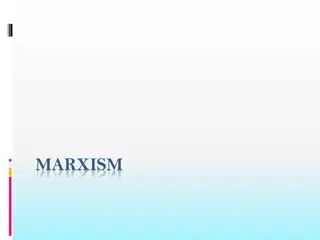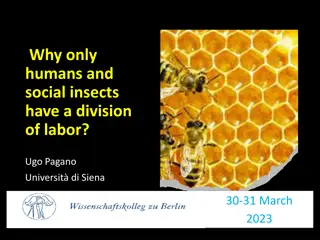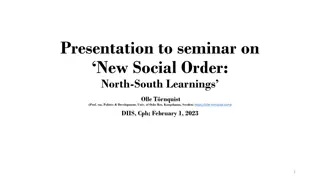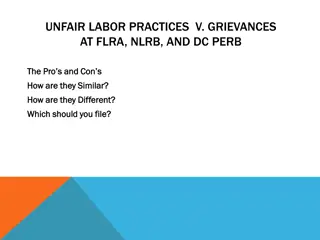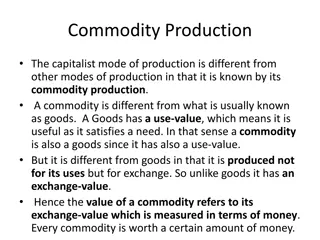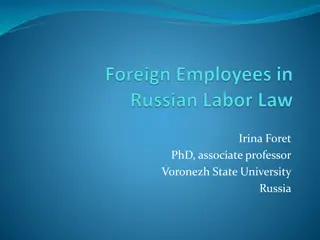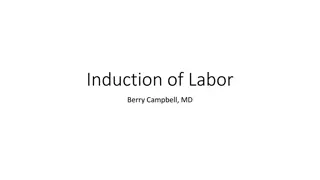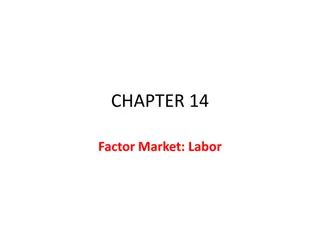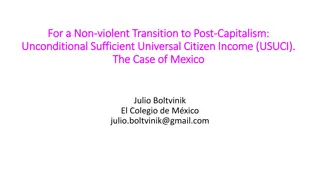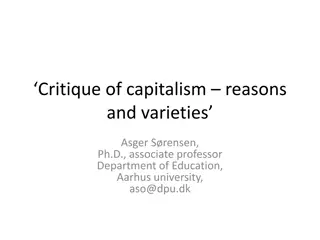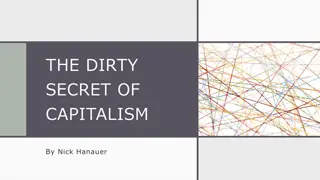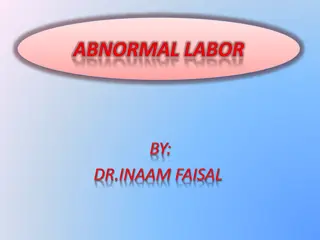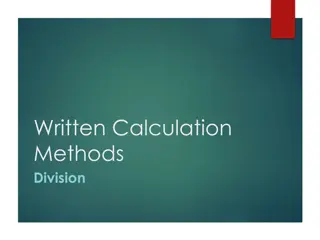The Division of Labor and Social Order in Capitalism
In capitalism, conflict is viewed as an essential component of social relations, leading to increased productivity and unity among individuals. The division of labor promotes specialization and efficiency in production, ultimately benefiting society as a whole. Comparative advantages and opportunity costs play a crucial role in determining optimal production strategies.
Download Presentation

Please find below an Image/Link to download the presentation.
The content on the website is provided AS IS for your information and personal use only. It may not be sold, licensed, or shared on other websites without obtaining consent from the author. Download presentation by click this link. If you encounter any issues during the download, it is possible that the publisher has removed the file from their server.
E N D
Presentation Transcript
The Division of Labor and Social Order Mises University Auburn, Alabama
Contrasting Views Rather than seeing conflict as an anomaly, it is concluded that conflict is an essential and inherent component of the social relations found in capitalism. Herb Thompsom, Conflict and the Social Relations of Capitalism The greater productivity of work under the division of labor is a unifying influence. It leads men to regard each other as comrades in a joint struggle for welfare, rather than as competitors in a struggle for existence. It makes friends out of enemies, peace out of war, society out of individuals. Ludwig von Mises, Socialism
Modes of Production Direct Use Production: Self-sufficiency. Direct correspondence between what people want and what they produce. Production for Exchange Oriented to what can be sold in a market Market division of labor
The Division of Labor Specialization of Production According to Efficiency Each person produces particular good in excess of personal consumption. His consumptive ends are met by others. Mises: Fundamental Social Phenomenon Been with us since the beginning of human history Great impetus for the formation of society
The Division of Labor Production Possibilities Opportunity Cost Proficiency Efficiency Mangoes Beef Mangoes Beef Both Goods Groucho: 300 or 600 2 B M Mangoes Harpo: 100 or 400 4 B M None Beef Who has absolute advantage in what? Groucho is more proficient in producing both goods. Who has the comparative advantage in producing mangoes? How much does it cost Groucho to produce 1 mango? 2 lb. of beef How much does it cost Harpo to produce 1 mango? 4 lb. of beef Who has a lower opportunity cost producing mangoes? Groucho
The Division of Labor Production Possibilities Opportunity Cost Proficiency Efficiency Mangoes Beef Mangoes Beef Both Goods Groucho: 300 or 600 2 B M Mangoes Harpo: 100 or 400 4 B M None Beef Who has the comparative advantage in producing beef? How much does it cost Groucho to produce 1 lb. of beef? mango How much does it cost Harpo to produce 1 lb. of beef? mango Who has a lower opportunity cost producing beef? Harpo
The Division of Labor Production for Direct Use Groucho Harpo 50 200 Total 200 500 Mangoes Beef (lbs.) 150 300 Production According to Efficiency Harpo 225 0 150 400 Total 225 550 Gain 25 50 Groucho Mangoes Beef (lbs.)
The Division of Labor Both Parties Benefit in Consumption Groucho and Harpo can exchange mangoes for beef at ratio of 1 mango for 3 lbs. beef. Harpo trades 180 lbs. of beef to Groucho for 60 mangoes. Consumption After Specialization and Trade Groucho Harpo Total Mangoes (bu.) 1000 225 60 = 165 0 + 60 = 60 Beef (lbs.) 150 + 180= 330 580 400 180 = 220 Gain 15M & 30B 10 M & 20B
Differences in Efficiency What accounts for the differences in relative costs of production for different people? Differences in suitability of natural resources. Differences in given capital. Differences in skill or desirability of labor.
The Division of Labor The Law of Association Each factor of production is efficient in some line of production Applies not only to labor, but also to land and capital goods. Implication: Employment can expand indefinitely
Social Effects of Division of Labor Initial differences become even more pronounced. Alters the economic geography. Increases the inequality in labor skills over time. Population Growth Harmonizes Social Interests
Limits to the Division of Labor Extent of the Market Only beneficial to specialize if product can be traded. To extend division of labor, bring others into market. Seeds of Theory of Economic Progress
Limits to the Division of Labor Must be able to exchange what we produce. Without trade, must produce everything we consume. Exchange requires private property. Hence, in order to take advantage of the division of labor, society must have private property.
Social Order Division of labor integrates world into an economic order. Global division of labor is not artificial. Natural result of human action.
Economic Calculation Challenge of Production for the Market Producers do not know exactly what other people want. Must make objective production decisions about future subjective preferences of other people. Specialized production of higher order capital goods require a corresponding quantity of other complementary producer goods.
Economic Calculation Coordination of economic order requires economic calculation. Requires market monetary prices. Economic Calculation requires medium of exchange. Requires prices be determined by process of voluntary exchange. Requires private property Requires sound money



